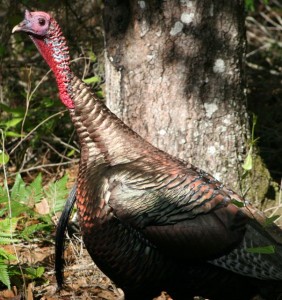
Lara Miller, Natural Resource Agent, UF/IFAS Extension
The eastern wild turkey (Meleagris gallopavo silvestris) is frequently spotted by visitors to Pinellas County’s Brooker Creek Preserve located in Tarpon Springs. The Preserve offers these large ground-foraging birds their preferred habitat of open forests and forest edges. Food sources of acorns, seeds, fruits, insects, leaves and small vertebrates are also abundant.
If you’re looking to spot a turkey, it is best to observe in the early morning hours when they are foraging for food on the ground. Closer to dusk, turkeys can be found roosting high up in the trees to avoid predators. Turkeys are especially fond of forest edges where nut-bearing trees such as oaks and hickories are found. During the spring and summer, you can listen for gobbling males. The gobble is a distinct call that can be heard for a long ways. Click here to hear their calls.
Did you know turkeys can fly too? It’s true. They are quite good at flying short distances and have been observed to reach 55 miles per hour! Flying is not a common site as it is very energy intensive, so turkeys are usually observed walking through wooded areas. During your observations, you may note the differences between male and female turkeys.
Adult male turkeys (featured in the photograph above) are heavier-bodied and larger than the females, lacking feathers on their heads. This reveals a pinkish-red skin with red caruncles (wattles) on its throat and neck. The skin on the males’ head will turn bright blue and white if the turkey becomes excited. At the same time their caruncles swell and become a vibrant red color. The body of male turkeys is distinguished by the beautiful dark brown/bronze iridescent feathers and a dark beard protruding from the breast area. During courtship in early spring, the male will puff out his feathers and fan out his tail while strutting to attract a female. This display is also accompanied by their distinct gobble call.
Females are drabber in appearance than the male with a bluish-gray head and a neck which lacks the bright red caruncles of the male turkey. Females also typically lack a beard, but some can display a significantly smaller and thinner beard at times. Nests are built by the females as they scratch a low depression in the ground. This cleared space amongst vegetation is then lined with grasses and dead leaves. Eggs are laid between March and April with an average clutch size of 10.3 eggs. These eggs take approximately 25-26 days to hatch following a continuous period of incubation. Mature turkeys roost (rest) up in trees to avoid predation, but young turkeys (called poults) roost on the ground for the first two weeks after hatching. This behavior contributes to a significant number of deaths from predation by raccoons, skunks, opossums, foxes, coyotes and domestic dogs. Male turkeys provide no parental care while the female leads and feeds her chicks for a few days until they are able to find food on their own. As the chicks mature, they will form groups or broods with several hens and will often be spotted in these large groupings.
Now you can see there is more than one way to enjoy turkeys during this holiday season. While many of us will enjoy feasting on turkey, a number of folks will also enjoy observing them in their backyards or on their family outings to a local park. If you live near Brooker Creek Preserve, stop by and see what you can observe in the largest remaining natural area in Pinellas County.
Sources:
http://myfwc.com/wildlifehabitats/profiles/birds/game-birds/turkeys/
http://www.allaboutbirds.org/guide/wild_turkey/sounds
Photo Source: Lara Miller (photo taken at Brooker Creek Preserve)
 0
0
